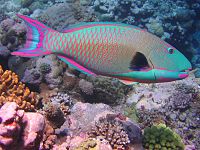Difference between revisions of "Cetoscarus bicolor"
From The Aquarium Wiki
| (12 intermediate revisions by 2 users not shown) | |||
| Line 4: | Line 4: | ||
|extra_common_names=Red-Specked Parrotfish, Spotted Parrotfish, Two-Color Parrotfish | |extra_common_names=Red-Specked Parrotfish, Spotted Parrotfish, Two-Color Parrotfish | ||
|species=Cetoscarus bicolor | |species=Cetoscarus bicolor | ||
| − | |extra_scientific_names=Scarus bicolor, Scarus pulchellus, Cetoscarus pulchellus | + | |extra_scientific_names=Scarus bicolor, Scarus pulchellus, Cetoscarus pulchellus, Bolbometopon bicolor |
| − | |image= | + | |image=Bicolor parrotfish.JPG |
|caption=Bicolor Parrotfish | |caption=Bicolor Parrotfish | ||
|availability=Uncommon | |availability=Uncommon | ||
| Line 37: | Line 37: | ||
}} | }} | ||
| − | = | + | {{Basic fish page |
| − | :Endemic to the Red Sea. | + | |origin=:Endemic to the Red Sea; Its Indo-Pacific range is disputed (see notes). |
| − | + | |sexing=:Hermaphroditic; males change to females, and back to males. | |
| − | = | + | |tank_compatibility=:Peaceful, mixes well with tankmates. |
| − | :Hermaphroditic; males change to females, and back to males. | + | |diet=:Eats algae off corals by scraping off coral with their strong, beak like mouths. |
| − | + | |feeding_regime=:Daily. | |
| − | + | |environment_specifics=:Reef tank, with coral structures to encourage grazing | |
| − | + | |behaviour=:Fairly Peaceful. Will stand ground if attacked by more aggressive species. | |
| − | :Peaceful, mixes well with tankmates. | + | |identification=:Juveniles are white, with an orange band bordered by black down the eyes. Adults are blue with red-purple markings. |
| − | + | }} | |
| − | + | ==Notes== | |
| − | + | *The species' actual range is disputed - some say the Indo-Pacific population outside of the Red Sea is a separate species entirely, ''Cetoscarus occellatus''. | |
| − | :Eats algae off corals by scraping off coral with their strong, beak like mouths. | ||
| − | |||
| − | |||
| − | |||
| − | :Daily | ||
| − | |||
| − | |||
| − | |||
| − | :Reef tank, with coral structures to encourage grazing | ||
| − | |||
| − | |||
| − | |||
| − | :Fairly Peaceful. Will stand ground if attacked by more aggressive species. | ||
| − | |||
| − | |||
| − | |||
| − | :Juveniles are white, with an orange band bordered by black down the eyes. Adults are blue with red-purple markings. | ||
==Pictures== | ==Pictures== | ||
| Line 74: | Line 57: | ||
|- | |- | ||
|Juvenile apecimen: | |Juvenile apecimen: | ||
| + | |- | ||
| + | |<youtube>EvvIe1EX6LY</youtube> | ||
| + | |} | ||
| + | |||
| + | {| | ||
| + | |- | ||
|Adult specimen: | |Adult specimen: | ||
|- | |- | ||
| − | |||
|<youtube>xmtHqlV4OzQ</youtube> | |<youtube>xmtHqlV4OzQ</youtube> | ||
|} | |} | ||
| − | ==External | + | ==External links== |
| − | *{{FishBase |id=}} | + | *{{FishBase |id=5538}} |
| − | *[ | + | *[[w:Cetoscarus bicolor|Wikipedia]] |
| − | *[http://www.freshmarine.com/bicolor-parrotfish.html | + | *[http://www.freshmarine.com/bicolor-parrotfish.html Fresh Marine] |
*[https://www.petsolutions.com/C/Live-Saltwater-Parrotfish/I/Bicolor-Parrotfish.aspx Petsolutions] | *[https://www.petsolutions.com/C/Live-Saltwater-Parrotfish/I/Bicolor-Parrotfish.aspx Petsolutions] | ||
*[https://www.bluezooaquatics.com/productDetail.asp?did=1&pid=963&cid=289 Blue Zoo Aquatics] | *[https://www.bluezooaquatics.com/productDetail.asp?did=1&pid=963&cid=289 Blue Zoo Aquatics] | ||
*[https://www.saltwaterfish.com/product-bicolor-parrotfish Saltwaterfish.com] | *[https://www.saltwaterfish.com/product-bicolor-parrotfish Saltwaterfish.com] | ||
| + | *[https://www.petsolutions.com/C/Live-Saltwater-Parrotfish/I/Bicolor-Parrotfish.aspx Petsolutions] | ||
*[http://eol.org/pages/204367/overview EOL] | *[http://eol.org/pages/204367/overview EOL] | ||
Latest revision as of 07:24, 22 December 2023
Bicolor Parrotfish
Cetoscarus bicolor
568 Litres (150 US G.)
50.8-55.9cm (20-22 ")
8.1 - 8.4
22.2-25.6°C (72 -78 °F)
8-12 °d
1:1 M:F
15-20 years
Family
Scaridae
Contents
Additional names
- Red-Specked Parrotfish, Spotted Parrotfish, Two-Color Parrotfish
Additional scientific names
- Scarus bicolor, Scarus pulchellus, Cetoscarus pulchellus, Bolbometopon bicolor
Origin
- Endemic to the Red Sea; Its Indo-Pacific range is disputed (see notes).
Sexing
- Hermaphroditic; males change to females, and back to males.
Tank compatibility
- Peaceful, mixes well with tankmates.
Diet
- Eats algae off corals by scraping off coral with their strong, beak like mouths.
Feeding regime
- Daily.
Environment Specifics
- Reef tank, with coral structures to encourage grazing
Behaviour
- Fairly Peaceful. Will stand ground if attacked by more aggressive species.
Identification
- Juveniles are white, with an orange band bordered by black down the eyes. Adults are blue with red-purple markings.
Notes[edit]
- The species' actual range is disputed - some say the Indo-Pacific population outside of the Red Sea is a separate species entirely, Cetoscarus occellatus.
Pictures[edit]
Videos[edit]
| Juvenile apecimen: |
| Adult specimen: |
External links[edit]
- Fishbase (Mirrors:
 )
)
